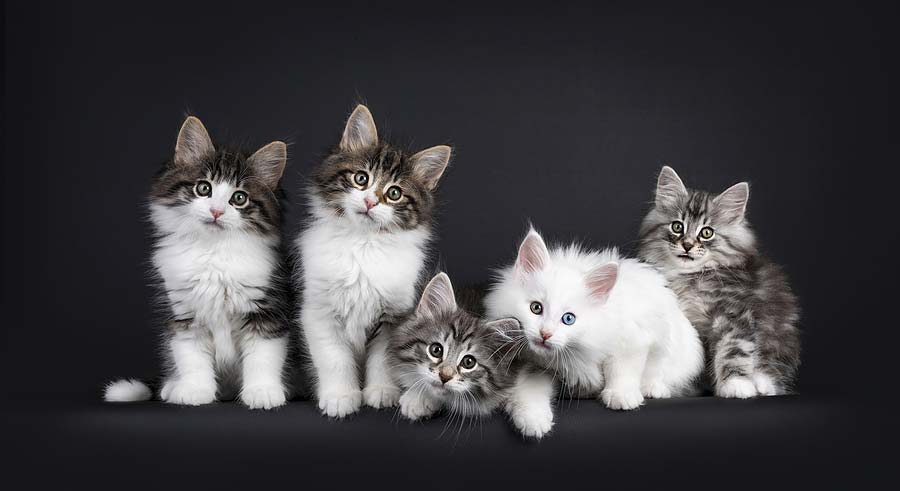Cats have individual personalities, reacting to people and their everyday surroundings in their own unique ways. A new study conducted in Finland takes a close look at five main personality and two common behavior traits with the goal of understanding more about cats to ensure that they are able to live their best lives in a domestic environment.
The study, “Reliability and Validity of Seven Feline Behavior and Personality Traits,”spearheaded by Professor Hans Lohi with a team of researchers in the Department of Veterinary Biosciences at the University of Helsinki, Finland, was based on behavior questionnaires submitted by Finnish cat owners and resulted in collecting information on more than 4,300 cats.
The study outlines the importance of identifying cat personality type, as cats with different personalities have different environmental needs to live their best life. It states, “active cats may need more enrichment, such as playing, than less active felines, and fearful cats may benefit from extra hiding places and an owner’s peaceful lifestyle.”
Further, knowing a cat’s personality allows shelter workers the opportunity to match a cat with the personality of a potential adopter. “For example, a feline’s personality directly affects its suitability for living in an adults-only household versus one with several boisterous children,” researchers report.
Study Details
The five feline personality traits the study focused on were fearfulness, activity/playfulness, aggression toward humans, sociability toward humans, and sociability toward cats. The two behaviors highlighted were excessive grooming and litter box issues.
Both pedigreed cats – 56 breeds total — and mixed-breed cats were studied. Further, the questionnaire took into account previous feline personality studies done worldwide. Researchers were able to endorse the findings of such studies in particular with regard to the way breeds differed in the traits, suggesting that individual genetic makeup came into play. Ultimately, of the 4,316 cats studied, 49 percent were females, and the majority – 69 percent — were neutered. The median age was 4.9 years.
Personality Trait: Fearfulness:
- Female cats were found to be more fearful.
- With regard to individual breeds, the Russian Blue, the Bengal, and various European breeds as well as mixed-breed housecats were considered more fearful than Cornish Rex, Burmese, Persian, and Exotic breeds.
- Cats with owner-reported problematic behaviors were found to be more fearful.
Personality Trait: Activity/Playfulness
- Older cats were found to be less active/playful.
- Fearful cats were less active/playful.
- The Cornish Rex, Korat, Bengal, and Abyssinian were more active/playful than British Shorthair, Ragdoll, Birman, Siberian, Neva Masquerade, Persian, and Exotic breeds.
Personality Trait: Aggression Toward Humans
- Older cats were found to be more aggressive.
- Cats living in multi-cat households were found to be less aggressive.
- Turkish Van and mixed-breed house cats were considered more aggressive than British Shorthair, Persian, Exotic, and Oriental breeds.
Personality Trait: Sociability Toward Humans
- Female cats were found to be less sociable.
- Fearful cats were also found to be less sociable.
- Active/playful cats were more sociable.
- Cats with reported problems were not less sociable than others.
- Korat, Oriental breeds, and Abyssinians were more social than British Shorthair, Birman, European Persian, and Exotic breeds.
Personality Trait: Sociability Toward Cats
- Older cats were less sociable.
- Female cats were less sociable.
- Fearful cats were less sociable.
- Cats with owner-reported problematic behavior were less sociable.
Behavior: Excessive Grooming
- Fearful cats were more likely to groom excessively.
- Burmese and Oriental breeds tend to groom more excessively than Siberian, Neva Masquerade, and Norwegian Forest cats.
- Cats with owner-reported problematic behavior tended to groom excessively.
Behavior: Litter Box Issues
- Older cats have more litter box issues.
- Male cats don’t have more litter box issues than females.
- Cats in multi-cat households don’t have more litter box issues than single-cat households.
- Cats with owner-reported problematic behavior have more litter box issues.
A Novel Finding
The study states that researchers “examined the discriminant validity of the questionnaire by investigating the correlations between factors and found only one moderate, negative correlation between aggression toward humans and sociability toward cats.”
Commenting on this by email, Salla Mikkola, PhDs, a doctoral researcher with the Lohi Research Group at the University of Helsinki and Folkhälsan Research Center, elaborated, saying that “this was a surprising and novel finding, as it has not been previously reported even though similar studies have been done.
“And, in addition, it would be more expected to find negative correlation between sociability toward humans and aggression toward humans than with cat sociability,” she says.
Mikkola, a pet parent to two cats named Tiuku, a 10-year-old housecat, and Tatjana, a 4-year-old Thai cat, both female, says her own felines are sociable toward humans and don’t show aggressiveness toward people.
“Tiuku is also very talkative and loud. Tatjana is more cat-social than Tiuku, who can act aggressively toward strange cats. For example, she growls if she sees a strange cat through a window in our yard,” she adds.
Commenting on the questionnaire and the research team’s next steps, Mikkola says, “The questionnaire and found traits were reliable and valid, and we will use the data and traits for further studies.
“Next, we will study how different environmental factors, biological factors, and personality affect three problematic behaviors: fearfulness, aggression toward humans and excessive self-grooming.”
This article was reviewed/edited by board-certified veterinary behaviorist Dr. Kenneth Martin and/or veterinary technician specialist in behavior Debbie Martin, LVT.








